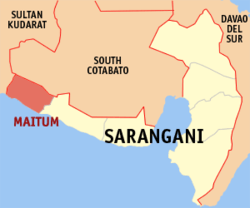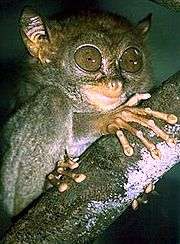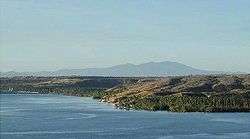Maitum, Sarangani
| Maitum | |
|---|---|
| Municipality | |
|
Coastal view of Maitum | |
 Map of Sarangani with Maitum highlighted | |
.svg.png) Maitum Location within the Philippines | |
| Coordinates: 06°02′N 124°29′E / 6.033°N 124.483°ECoordinates: 06°02′N 124°29′E / 6.033°N 124.483°E | |
| Country | Philippines |
| Region | SOCCSKSARGEN (Region XII) |
| Province | Sarangani |
| District | Lone district |
| Founded | May 7, 1959 |
| Barangays | 19 |
| Government[1] | |
| • Mayor | Pepito L. Catimbang |
| Area[2] | |
| • Total | 290.66 km2 (112.22 sq mi) |
| Population (2010)[3] | |
| • Total | 41,675 |
| • Density | 140/km2 (370/sq mi) |
| Time zone | PST (UTC+8) |
| ZIP code | 9515 |
| Dialing code | 83 |
| Income class | 2nd class |
| Website |
www |
Maitum is a second class municipality in the province of Sarangani, Philippines. According to the 2010 census, it has a population of 41,675 people.[3] As of 2010, it has a total voting population of 23,551 voters.[2]
It is bordered on the west by the province of Sultan Kudarat, on the east by the municipality of Kiamba, on the north by the province of South Cotabato, and on the south by the Celebes Sea.
History
According to local folklore, "Maitum" refers to the black stones in Saub River. It is believed that the river stones turned black when the local native princess and her warrior lover passed through it as they eloped and escaped from the wrath of the princess' father who disapproved their marriage. "Maitum" is a native word meaning black.
In 1928, Maitum became part of the municipality of Kiamba. It became a separate municipality on May 7, 1959, through Republic Act No. 2189.
Barangays
Maitum is politically subdivided into 19 barangays.[2]
- Batian
- Kalaneg
- Kalaong
- Kiambing
- Kiayap
- Mabay
- Maguling
- Malalag
- Mindupok
- New La Union
- Old Poblacion
- Pangi
- Pinol
- Sison
- Ticulab
- Tuanadatu
- Upo
- Wali
- Zion
Demographics
| Population census of Maitum | ||
|---|---|---|
| Year | Pop. | ±% p.a. |
| 1990 | 25,640 | — |
| 1995 | 35,009 | +6.01% |
| 2000 | 35,536 | +0.32% |
| 2007 | 37,054 | +0.58% |
| 2010 | 41,675 | +4.37% |
| Source: National Statistics Office[3] | ||
The majority of the population are of Ilocano origin. One of the indigenous peoples living in mountainous areas of Maitum is known as T'boli. The annual Binuyugan Festival is celebrated in May.
Internationally, Maitum is known for the discovery of very old cave artifacts called Maitum Anthropomorphic Potteries in one of the caves nearby. Ancient burial jars were discovered by archaeologists from the National Museum in Ayub Cave, Maitum, in 1991 and in 2008, at Sagel Cave, Maitum (now declared by National Historical Institute as a national historical sites). Amid Mindanao's armed conflicts, artifacts found thereat prove settlements of pre-historic civilization in Maitum.[4][5]
Economy

The economy of Maitum is largely based on agriculture and is often called the "rice-granary" of Sarangani due to its high level production of rice. Aqua-culture is the second biggest income earner, notably the culture of milkfish (bangus), prawns (particularly giant prawns) and shrimps for export. Other agricultural products are coconuts, corn, rubber, bananas, mangoes, pork, eggs, beef, and fish. Maitum is also a food basket nationally famous for its marinated flying fish.
The economy has accelerated in the past decade driven by advances in global communication technology and the finishing of a modern highway that tremendously improved trade and transport.
Wildlife

Tarsiers have been discovered in Maitum's mountainous areas.
Caves and the rainforest of Maitum are the natural habitat of a rare fruit bat species called giant golden-crowned flying fox (Acedoron jubatus), also known as "silent planter," since it contributes greatly to forest regeneration, because of eating lots of fruits and their seeds.[6] The rare writhed-billed hornbill and Mindanao hornbill are also found in the surrounding rainforest. The Philippine eagle (a monkey-eating eagle) also thrives in the area.
Endangered hawksbill turtles have their nesting grounds in Maitum's former main village called "Old Poblacion".
Other wild animals are wild boar, deer, monkeys, and various species of snake.
Sea turtles or pawikan can also be found in Maitum, Sarangani specifically at the Pawikan Nesting Sanctuary founded in 2003.
References
- ↑ "Official City/Municipal 2013 Election Results". Intramuros, Manila, Philippines: Commission on Elections (COMELEC). 11 September 2013. Retrieved 14 May 2014.
- 1 2 3 "Province: SARANGANI". PSGC Interactive. Makati City, Philippines: National Statistical Coordination Board. Retrieved 14 May 2014.
- 1 2 3 "Total Population by Province, City, Municipality and Barangay: as of May 1, 2010" (PDF). 2010 Census of Population and Housing. National Statistics Office. Retrieved 14 May 2014.
- ↑ pia.gov.ph, Island resort now Sarangani landmark
- ↑ balita.ph/2008/11, Sarangani gears for foundation anniversary festival
- ↑ www.gmanews.tv/video, Born to be Wild: Giant Bats, 07/03/2008
External links
| Wikimedia Commons has media related to Maitum, Sarangani. |
- Maitum Municipal Profile at the Province of Sarangani Official Website
- Official Website of the Municipality of Maitum
- Philippine Standard Geographic Code
- Philippine Census Information
- Local Governance Performance Management System
- Maitum cave yields artifacts similar to 1991 find
- globalnation.inquirer.net
 |
Lake Sebu, South Cotabato |  | ||
| Palimbang, Sultan Kudarat | |
Kiamba | ||
| ||||
| | ||||
| Celebes Sea |
